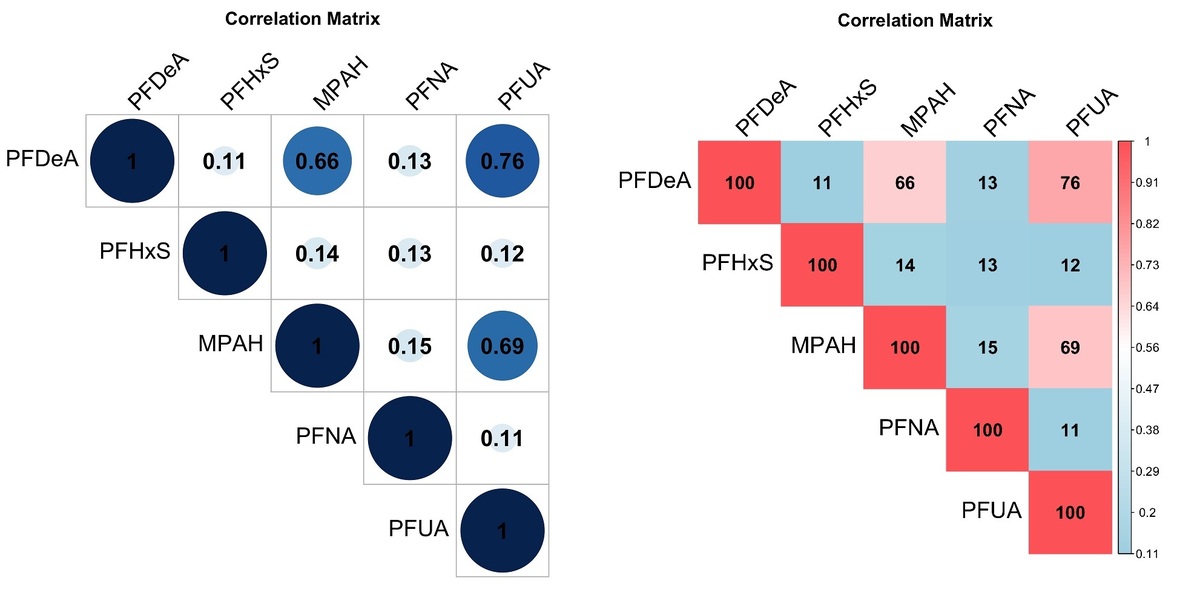Current issue
Archive
Manuscripts accepted
About the Journal
Editorial office
Editorial board
Abstracting and indexing
Subscription
Contact
Ethical standards and procedures
Most read articles
Instructions for authors
Article Processing Charge (APC)
Regulations of paying article processing charge (APC)
DIABETOLOGY / RESEARCH PAPER
The association between mixed exposure to per- and polyfluoroalkyl substances (PFAS) and the risk of diabetes
1
Yuyao People's Hospital, China
Submission date: 2024-02-20
Final revision date: 2024-03-27
Acceptance date: 2024-04-09
Online publication date: 2024-05-02
KEYWORDS
TOPICS
ABSTRACT
Introduction:
This study aims to investigate the relationship between exposure to per- and polyfluoroalkyl substances (PFAS) and the risk of diabetes by analyzing a large dataset from the National Health and Nutrition Examination Survey (NHANES).
Material and methods:
This study analyzed data from the US NHANES database from 2003 to 2018. Generalized linear regression models were used to examine the relationship between serum chemical concentrations and diabetes. Weighted quantiles and regression were employed to assess the association between mixed chemical exposure and diabetes. The 'mixture effect' between chemicals and diabetes was estimated using a Quantile g-Computation model.
Results:
The study involved 11,780 participants, with 1,451 individuals having diabetes and 10,329 being non-diabetic. Logistic regression analysis was to investigate the relationship between five PFAS chemicals and the diabetes risk, while controlling for all covariates. The results indicated that none PFAS chemicals exhibited a statistically significant association with an increased risk of diabetes. However, when exploring the positive and negative constraint models of the Weighted Quantile Sum (WQS), the coefficient of the chemical mixing index displayed a strong correlation with diabetes in model III, even after adjusting for covariates. Additionally, an evaluation of the 'mixture effect' using Quantile g-computation revealed that among the five chemicals, the combined exposure effect of Perfluorononanoate (PFNA) on diabetes was positive, whereas exposure to the other four chemicals had a negative impact.
Conclusions:
The study findings suggest a possible connection between PFAS and an increased risk of diabetes, particularly highlighting PFNA's positive correlation with the combined exposure effect on diabetes.
This study aims to investigate the relationship between exposure to per- and polyfluoroalkyl substances (PFAS) and the risk of diabetes by analyzing a large dataset from the National Health and Nutrition Examination Survey (NHANES).
Material and methods:
This study analyzed data from the US NHANES database from 2003 to 2018. Generalized linear regression models were used to examine the relationship between serum chemical concentrations and diabetes. Weighted quantiles and regression were employed to assess the association between mixed chemical exposure and diabetes. The 'mixture effect' between chemicals and diabetes was estimated using a Quantile g-Computation model.
Results:
The study involved 11,780 participants, with 1,451 individuals having diabetes and 10,329 being non-diabetic. Logistic regression analysis was to investigate the relationship between five PFAS chemicals and the diabetes risk, while controlling for all covariates. The results indicated that none PFAS chemicals exhibited a statistically significant association with an increased risk of diabetes. However, when exploring the positive and negative constraint models of the Weighted Quantile Sum (WQS), the coefficient of the chemical mixing index displayed a strong correlation with diabetes in model III, even after adjusting for covariates. Additionally, an evaluation of the 'mixture effect' using Quantile g-computation revealed that among the five chemicals, the combined exposure effect of Perfluorononanoate (PFNA) on diabetes was positive, whereas exposure to the other four chemicals had a negative impact.
Conclusions:
The study findings suggest a possible connection between PFAS and an increased risk of diabetes, particularly highlighting PFNA's positive correlation with the combined exposure effect on diabetes.
We process personal data collected when visiting the website. The function of obtaining information about users and their behavior is carried out by voluntarily entered information in forms and saving cookies in end devices. Data, including cookies, are used to provide services, improve the user experience and to analyze the traffic in accordance with the Privacy policy. Data are also collected and processed by Google Analytics tool (more).
You can change cookies settings in your browser. Restricted use of cookies in the browser configuration may affect some functionalities of the website.
You can change cookies settings in your browser. Restricted use of cookies in the browser configuration may affect some functionalities of the website.



